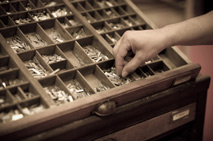
About Our Books
The Happy Dragons’ Press Recipe
First catch your poet! Our editors (Rosemary Grant and Shirley Toulson) select only the very best material for us to publish, whether it's from established poets or new talent.
Next we choose an artist with a style we think will compliment the poetry, then we give them free reign to illustrate the work as they see fit. Most of our artists produce lino- or wood-cuts which we can print from directly.
Once we have the manuscript and artwork, we start the lengthy printing process.
- The poems are type set by hand, letter by letter, using metal printers’ type.
- Paper is fed one sheet at a time into one of our antique treadle operated printing presses.
- The printer carefully controls the pressure to make the perfect ‘impression’ when the paper touches the inked type.
- A typical 110 copy ‘New Garland’ edition requires 3300+ impressions.
- Most of our illustrations are lino-cuts or wood-cuts. You won't often find these reproduced directly from the artist-cut block outside of a gallery, but that's exactly what we do. If there's more than one colour involved, each must be printed separately and allowed to dry before the next is added.
- For line-drawn art and some other special cases we use chemically etched nylon blocks. Once the cutting edge of technology, there are now only a handful of people capable of making them.
- We use a unique ‘twin-wire’ paper produced by Tullis Russell in Fife, and the cover boards come from James Cropper & Sons in Kendal.
- The pages are sewn together by hand and mounted in their covers. They spend a night in a ‘nipping press’ before, finally, being trimmed down to size.

The Environment
Needless to say, printing and binding by hand and using British made papers keeps the environmental cost of our books very low. The paper is FSC certified and the inks are linseed oil based. Our consumption of electricity is limited to lighting and occasional heating. The presses operate with a foot pedal and even the guillotine is hand operated!
Why Not-for-Profit?
We want to help preserve letterpress and we don't think that's possible if letterpress printed books remain the sole preserve of collectors.
We'd like everyone to have the chance to discover first-hand why the technique is worth preserving and, with so many museums closing, that's getting harder all the time.
To keep our books at an accessible price, the poets, artists, editors, printer and book binding elves all give their time to the project for free. This means that the money from sales can be invested in the next book and in the new, information-based, sections of our website. It also gives us a chance to experiment with new techniques and materials which a truly commercial enterprise would not have the time for.
